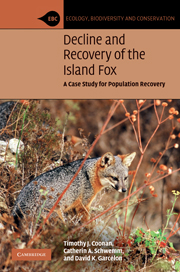Book contents
- Frontmatter
- Contents
- Foreword
- Acknowledgments
- 1 Introduction
- 2 Evolution and genetics
- 3 Social structure, reproduction, mortality and survivorship, and population dynamics
- 4 Food habits, habitat use, activity patterns, and dispersal
- 5 Golden eagles and the decline on the northern islands
- 6 Ecosystem recovery
- 7 Disease and decline on Santa Catalina Island
- 8 Recovery actions
- 9 Recovery actions
- 10 Reproductive biology, by Cheryl Asa
- 11 Diseases of island foxes, by Linda Munson
- 12 Zoos, education, and public participation
- 13 Managing recovery
- 14 The ecological role of island foxes
- 15 Conclusion
- References
- Index
6 - Ecosystem recovery
Predators and prey on the northern Channel Islands
Published online by Cambridge University Press: 05 October 2010
- Frontmatter
- Contents
- Foreword
- Acknowledgments
- 1 Introduction
- 2 Evolution and genetics
- 3 Social structure, reproduction, mortality and survivorship, and population dynamics
- 4 Food habits, habitat use, activity patterns, and dispersal
- 5 Golden eagles and the decline on the northern islands
- 6 Ecosystem recovery
- 7 Disease and decline on Santa Catalina Island
- 8 Recovery actions
- 9 Recovery actions
- 10 Reproductive biology, by Cheryl Asa
- 11 Diseases of island foxes, by Linda Munson
- 12 Zoos, education, and public participation
- 13 Managing recovery
- 14 The ecological role of island foxes
- 15 Conclusion
- References
- Index
Summary
By 1999 monitoring and research had revealed both the deep decline of island fox populations on the northern islands and the primary cause: predation by golden eagles. Averting extinction for the three subspecies (on Santa Cruz, Santa Rosa, and San Miguel) would require quick and effective emergency actions to protect the remaining foxes (Chapter 8) and mitigate predation. Complete recovery to viable population levels was a distant goal at the time, but it was clear that persistence of island fox populations would require ecosystems that functioned as they had historically, i.e. without golden eagles. This chapter discusses the management challenges of removing golden eagles, as well as the substantial effort required to restore island ecosystems to conditions that would deter golden eagle establishment in the future. These ecosystem-level actions included the restoration of bald eagles to the islands, and the removal of feral pigs.
Golden eagle removal
While the threat of critically low population size could conceivably be mitigated through captive breeding and reintroduction (Chapters 8 and 9), such efforts would be futile unless the threat from golden eagles was eliminated. Golden eagles had been live-captured and relocated from some areas in western North America to reduce depredation on livestock, with moderate success (Phillips et al. 1991). Brian Walton of the Santa Cruz Predatory Bird Research Group (SCPBRG) surmised that similar methods could be used to translocate golden eagles from the Channel Islands.
- Type
- Chapter
- Information
- Decline and Recovery of the Island FoxA Case Study for Population Recovery, pp. 58 - 72Publisher: Cambridge University PressPrint publication year: 2010



